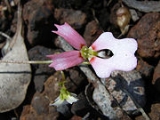
Stylidium subg. Centridium
Encyclopedia
Stylidium subg. Centridium is a subgenus
of Stylidium that is characterized by a globose hypanthium, a stipitate brush-like stigma, and gynostemium mobility not produced by a sensitive hinged torosus but by the movement of a cunabulum. All species with the possible and doubtful exception of S. weeliwolli are annuals. This subgenus appears to be most closely related to the genus Levenhookia
, which suggests an ancestral relationship. Centridium was first published by John Lindley
in the 1839 publication, A Sketch of the Vegetation of the Swan River Colony
. Lindley created this subgenus to distinguish species which did not fit into either of the two other subgenera that had existed at the time. He initially placed Stylidium calcaratum
, the newly described Stylidium androsaceum
, and Stylidium stipitatum into subgenus Centridium. His description of S. androsaceum turned out to be synonymous with S. calcaratum and S. stipitatum is a synonym of Levenhookia stipitata
.
Subgenus
In biology, a subgenus is a taxonomic rank directly below genus.In zoology, a subgeneric name can be used independently or included in a species name, in parentheses, placed between the generic name and the specific epithet: e.g. the Tiger Cowry of the Indo-Pacific, Cypraea tigris Linnaeus, which...
of Stylidium that is characterized by a globose hypanthium, a stipitate brush-like stigma, and gynostemium mobility not produced by a sensitive hinged torosus but by the movement of a cunabulum. All species with the possible and doubtful exception of S. weeliwolli are annuals. This subgenus appears to be most closely related to the genus Levenhookia
Levenhookia
Levenhookia, also known as the styleworts, is a genus of ten recognized species in the family Stylidiaceae and is endemic to Australia. The genus is restricted to Western Australia almost exclusively with a few exceptions: L. pusillas range extends into South Australia, L. dubias range extends...
, which suggests an ancestral relationship. Centridium was first published by John Lindley
John Lindley
John Lindley FRS was an English botanist, gardener and orchidologist.-Early years:Born in Catton, near Norwich, England, John Lindley was one of four children of George and Mary Lindley. George Lindley was a nurseryman and pomologist and ran a commercial nursery garden...
in the 1839 publication, A Sketch of the Vegetation of the Swan River Colony
A Sketch of the Vegetation of the Swan River Colony
A Sketch of the Vegetation of the Swan River Colony, also known by its standard botanical abbreviation Sketch Veg. Swan R., is an 1839 article by John Lindley on the flora of the Swan River Colony...
. Lindley created this subgenus to distinguish species which did not fit into either of the two other subgenera that had existed at the time. He initially placed Stylidium calcaratum
Stylidium calcaratum
Stylidium calcaratum, the book triggerplant, is a dicotyledonous plant that belongs to the genus Stylidium . It is an ephemeral annual that grows from 5 to 10 cm tall but can grow larger at 20–30 cm tall in damp forest or scrub habitat. The few ovate leaves produced by this plant form...
, the newly described Stylidium androsaceum
Stylidium androsaceum
Stylidium androsaceum is an invalid species name that can refer to:*Stylidium calcaratum, published as S. androsaceum Lindl. in early December 1839.*Stylidium ericksoniae, published as S. androsaceum O.Schwarz in 1927....
, and Stylidium stipitatum into subgenus Centridium. His description of S. androsaceum turned out to be synonymous with S. calcaratum and S. stipitatum is a synonym of Levenhookia stipitata
Levenhookia stipitata
Levenhookia stipitata, the common stylewort, is a dicotyledonous plant that belongs to the genus Levenhookia . It is an ephemeral annual that grows about 7 to 10 cm tall with oblanceolate to linear leaves. Flowers are pink and bloom from August to January in its native range. L...
.

